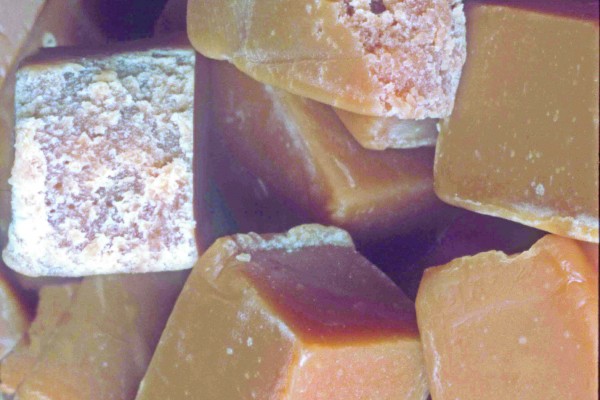Full steam ahead

Bill Edwards discusses developments in the cooking and depositing of sugar confectionery.
The production of confectionery that requires heating started using a saucepan on a stove. However, very few confectionery products are now cooked using direct heat. Most confectionery plant uses steam as a means of heating, one of the advantages of which is that the temperature of the plant can never rise above that of the steam.
Using steam for heating means that a source of steam is needed and traditionally a factory would have a central boiler with steam being distributed around the factory via lagged pipes. A recent innovation is the steam generator. This device uses a gas fired flash boiler that can provide steam at the point of use. The gas is piped to where the steam is needed and the steam is generated as close as possible to that point.
A way of avoiding the need for a steam supply is by using a self-generating steam pan. These devices use a closed steam circuit to provide steam using either gas or electric heating. A traditional steam pan is copper with a steam heating jacket, although some are now made of stainless steel. Some producers believe that this sort of pan gives the best flavoured toffee and fudge. However, confectionery is now cooked using a whole range of equipment from the traditional steam pan through various proprietary cookers to large custom designed continuous plants.
Ingredients
When we consider cooking confectionery, it is important to remember what we are seeking to achieve. Initially one of the aims will be to dissolve ingredients, usually sugar. Then the product will have to be brought to its final concentration. In some products, such as toffee and caramel, it is desirable to brown the product – that is to cause it to undergo the Maillard reaction between proteins and reducing sugars. In other products, such as fondant, browning is undesirable.
When all the ingredients have been dissolved, the next stage is likely to be concentrating the product before depositing. This is the process that takes the most time and uses the most energy since not only does the temperature of the product have to be raised but the latent heat of evaporation has to be supplied to the product to remove the excess water.
Each stage can be improved either on a batch or a continuous process. Dissolving can be accelerated by raising the pressure above atmospheric to increase the temperature. At a higher temperature, sugar dissolves more quickly and in less water. Using less water not only saves the cost of the water, it also saves time and energy during the concentration stage when less water has to be evaporated.
Evaporation
The efficiency of heating and hence evaporation in a pan is limited by the rate at which heat can pass into the product. This rate is limited by the low thermal conductivity of the product. A heat exchanger can heat the product much more quickly since the distance from the heated surface to the centre of the product is reduced. An extreme case is a thin film heat exchanger where the thin film of product can be heated very rapidly.
The rapid and efficient heating of heat exchangers creates a problem with products such as toffees. These products depend on the development of flavour and colour during cooking, but when cooked using a high speed continuous cooker very little colour or flavour development occurs. The usual solution to this problem is to add a carameliser to the plant. A carameliser is a steam heated stirred open vessel where the cooked product is held until sufficient colour and flavour have developed. The carameliser can bear a strong resemblance to a steam pan.
Evaporation from a product can be speeded up using a vacuum. A typical small scale plant would boil the sugar and glucose mixture and then apply a vacuum. The vacuum causes the mixture to boil at reduced pressure bringing it to final solids, cooling the mass and de-aerating it.
The modern style of water white uncaramelised high boilings is only possible using vacuum boiling. However, when manufacturers set out to make sugar free high boilings using isomalt, a new problem occurred. While the usual ingredients in these products do not undergo the Maillard reaction, the finished product must have a low moisture content in order to be stable. While this could be achieved in principle by running a conventional vacuum boiling plant at a higher temperature, the temperature required is above that of the steam in most factories.
The cost of a higher pressure boiler and piping would be considerable making the process uneconomical. A solution was found by modifying the plants to boil under vacuum, which meant that the products could be made with a sufficiently low water content to be stable but using the existing steam supply. As it was possible to retrofit a facility to existing plant, the take up was rapid.
One of the problems that occurs when cooking toffees is that if the plant is changed, particularly from a batch plant to a continuous one, the texture of the finished product alters. It is therefore important to check the level of sugar inversion in the two versions. Continuous plants tend to produce a lower amount of sucrose inversion because they cook the product so quickly. The solution to this problem is to adjust the ratio of sucrose to invert sugar in the recipe. A considerable amount of effort can be involved in producing a toffee with the same texture using two different plants.
Shaping
All of the cooking methods described so far use heat from steam. Although some years ago there was interest in cooking toffee using direct electrical heating, this appears not to be used in practice.
When the product has been cooled and any flavours, colours and other ingredients have been added it is shaped, usually by depositing. Two technologies are used during this process: starch moulding and starchless moulding. Starch moulding is the most well established.
In a starch moulding plant the product is deposited into depressions in trays of moulding starch. Moulding starch is a starch that has had a small quantity of a long life vegetable oil added to improve its binding ability. The practice of using mineral oil for this purpose has been banned.
The impressions are stamped into the starch with a mould board. One of the benefits of this process is that changing the mould board is relatively inexpensive. Therefore one plant can easily be changed to produce a whole range of different shapes and piece weights.
If the product has not been deposited at the final solids stage, the trays are moved to a stove to dry to the required moisture content. Some products cannot be deposited at final solids either because the liquor would become too viscous or because the structure needs time to build up.
When the product has reached the required solids either by stoving or depositing, the trays are inverted over a sieve. The product is retained on the sieve while the starch passes through to be dried and reused. The sweets are then dusted, cleaned and sometimes polished.
A starchless moulding system will deposit into rubber or metal moulds. In this type of system the product shape or weight can only be altered by using a different set of moulds, which would typically cost thousands of euros. Starchless systems avoid the cost of the starch, starch handling and drying, but incur the expense of the moulds, which exceeds that of the starch moulds.
The first starchless moulding systems needed less labour than a starch system since there are no trays to stack and move around. Modern starch systems handle the trays mechanically reducing the need for manpower. It is possible to build a starch moulding system that automates the process from depositing through stoving to the discharge of the finished product.
The best system for a particular factory depends on the nature of the operation. Starchless moulding is best suited to producing a limited number of products by depositing at final solids. It is best suited to an operation where things cannot be changed without first conducting extensive market research.
Starch moulding is best suited for making products that need stoving and for factories that need flexibility, for example, factories that produce a wide range of products possibly for the own label market.
Conclusion
The process of cooking confectionery has come a long way since saucepans were used to incorporate machinery ranging from steam heated pans to large continuous plants.
Similarly, depositing has moved from labour intensive starch depositing to modern automated starch depositing or starchless moulding plants. The aim in both cooking and depositing as ever is to supply to the consumer the high quality products they know and desire at an affordable price.



